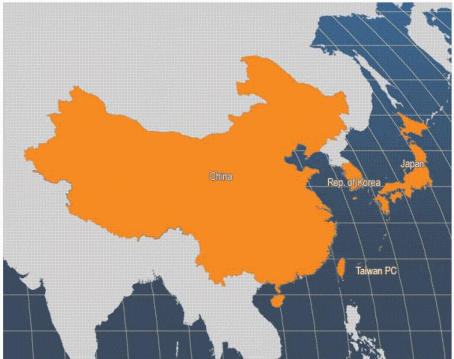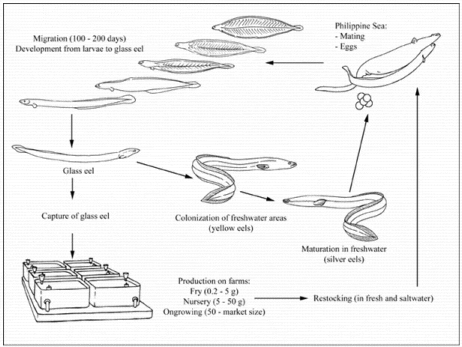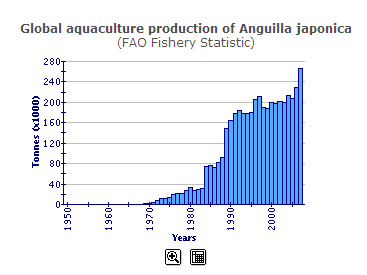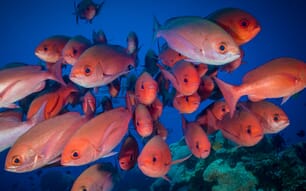Identity
Anguilla japonica Temminck & Schlegel, 1847 [Anguillidae]
FAO Names: En - Japanese eel, Fr - Anguille du Japon, Es - Anguila japonesa

Biological features
Body elongate, cylindrical anteriorly, compressed posteriorly, fleshy and smooth. Mouth corner extending to posterior margin of eyes. Lower jaw slightly longer than upper. Lips with fold, symmetrical. Snout depressed and stout. Distance between dorsal fin origin and vent varies from 9.0 to 13.5 per cent of total body length. Head length 11.2 to 11.9 per cent in body length. Upper jaw length contained from 3.7 to 4.3 times in head length. Length of pectoral fin from 2.2 to 3.7 per cent of head length. Teeth small, conical, in cardiform bands on jaws and vomer. Maxillary teeth in a narrow band. Vomerine teeth band slightly broader and longer than (or as long as) that of maxillary (Chen & Weng, 1967). Dorsal and anal fins confluent with caudal fin. Distance between origins of dorsal and anal shorter than head length. Body covered with rudimentary imbedded scales which arranged in small groups and placed obliquely at right angles to those of neighboring groups. Plain-colored, not marbled or mottled. Specimens in alcohol are uniformly dark brown on the back and lighter on the belly. 114 to 117 vertebrae (average 115.8).
View SIDP Species fact sheet
Profile
Historical background
Eel aquaculture began in Tokyo, Asia in 1879, with the raising of elvers, while Taiwan Province of China and the Republic of Korea initiated eel culture in 1968 and the People's Republic of China in 1975. The eel farmers of China are major producers, many of the farms being found in Guangdong province; a large proportion are exported live or as kabayaki to Japan. With an annual demand of 130 000 tons, Japan constitutes the most important eel market in the world; its own production (mainly from aquaculture), however, is insufficient to cover demand. The difference is mainly imported from China, Taiwan Province of China, the Republic of Korea and Malaysia.
During the last four decades, however, the quantity of Japanese glass eels caught in Asia has fallen considerably. With the relatively abundant supplies of European glass eels (Anguilla anguilla) and cheap prices compared to those for Japanese species, 70 per cent of the eel farms in the People's Republic of China began to rear them at the end of the 1990s. While the catch of glass eels in Japan in 1965 amounted to 140 tons, it had fallen below 40 tons by 2000. The principal restriction on the volume of eel culture in Japan is the availability of fry. Scientists are attempting to overcome this problem by breeding eels in captivity, but so far little or no success has been achieved.

Habitat and biology
Young Japanese eels enter rivers in small shoals from February to May, and ascend to the upper reaches of rivers and mountain lakes. After several years in freshwater and with the onset of sexual maturity, the eels migrate downstream and enter the sea from August to October. However, some Japanese eels have never entered freshwater (sea eels); in fact three different categories of eels are found, each with a different migratory history: river eels, estuarine eels and sea eels. Anguilla japonica has a flexible pattern of migration, with an ability to adapt to various habitats and salinities. Anguillid eel migrations into freshwater are clearly not an obligatory migratory pathway, and this form of diadromy should be defined as facultative catadromy, with the sea eel as one of several ecophenotypes.
Adults feed on benthic crustaceans, bony fish and insects. Japanese eels have very similar migratory and recruitment styles to European eels. The spawning of A. japonica occurs near some of the seamounts in the West Mariana Ridge. The Japanese eel is found widely around Japan and China. The northern limits are the island of Hokkaido, the coast of the Bohai Sea and the Liao Ho River. The southern limits are the island of Hainan and the Gulf of Tonkin. The distribution extends towards the Benin Islands.
Production

Production systems
The production of eels is based on wild catches of glass eels (elvers) that are used for further on-growing. Glass eels and elvers are best cultured in indoor tanks before being moved into grow-out facilities. Gro-wout of elvers to market size can be achieved in either tank systems or earthen ponds. Seed supply
Glass eels are captured around the shores of China, Taiwan Province of China, the Republic of Korea and Malaysia, and are either used nationally or exported to eel farmers in other countries.
Nursery
At first the glass eels (~0.2 g each) are kept in smaller tanks of 80-100 m3 for quarantine purposes. The density at this stage is 0.3-0.5 kg/m3. Water temperature is kept stable at 25-29 ºC. The eels are examined for diseases and, following diagnosis, treated. They are also weaned onto artificial diets with bloodworm and, later on, dry starter feed. When the eels reach approximately 5 g they are transferred to a juvenile production unit with larger tanks (300-600 m³) at stocking densities of 0.8-1.0 kg/m2. At this point the eels can digest dry feed pellets (1 mm).
Ongrowing techniques
Extensive pond systems
The traditional form of eel culture in the People's Republic of China is in earthen ponds, which should be constructed on non-porous soils. It is possible to line ponds so that they do not leak; however, the costs of construction are higher. Ponds range in size from 3 000-5 000 m2, and are 1 to 1.5-2.0 m deep. When eels reach marketable size, they are transferred to larger ponds (5 000-10 000 m2). The ponds may be static or flow-through. The best temperature range in ponds is 20-30 ºC. Individual growth rates vary substantially; grading every five weeks is necessary in order to reach a high overall growth performance.
Cement tanks systems
These systems consist of square or circular tanks from 100-300 m2, usually built of cement. The eels are stocked at a size of 50 g. Densities reach up to 1-5 kg/m2. Extruded dry feed (1.5-3 mm) is fed several times a day. Grading every 6-7 weeks is necessary.
Feed supply
Eel feeds are high carbohydrate (about 22 percent) and have a high fish meal content (65-70 percent) and crude protein level of 50 percent. Besides fish meal, other common ingredients are yeast, wheat, soybean meal, starch, corn, dicalcium phosphate, vegetable or animal fat, and trace mineral and vitamin premixes. Most eels (approximately 95 percent or more) are fed powdered feeds, and are fed 2-3 times daily. As the powered feeds are dry, water and fish oil are added to the mixture and the mixture is passed through a milling machine on-farm. In the People's Republic of China there are more than 100 feeds mills that produce a total of 350 000 tonst of eel feed.
Harvesting techniques
Eels are harvested at a weight varying from 150 g to several kilograms, depending on the target market. Feeding is stopped a minimum of 1-2 days before harvesting. Harvesting can be carried out by draining the pond, using a seine net or (at feeding time) using a scoop net. The eels are then sorted into different sizes using a grading system. Eels that have not reached market size are returned to the rearing tanks for further ongrowing.
Handling and processing
After harvesting, eels are rapidly sorted into different sizes, using grading systems. The eels are then placed in holding tanks for several days without feed to purge their stomachs. They are chilled and then packed into strong plastic bags with just enough water to ensure that their skin remains moist. The bags are then filled with oxygen and transported to the market. If they are destined for processing they are transported live to the processing plant.
Production costs
The cost of glass eels (elvers) varies significantly depending on annual catches and the interest from other eel producers. The price of Japanese glass eels has risen enormously; sometimes they cost well over USD 10 000/kg. The eel farmers of the People's Republic of China produce eels considerably more cheaply than in other producing countries. Whereas production costs in there are USD 3.6-4.2/kg, they are USD 4.2-5.6/kg in Taiwan Province of China and USD 8.4/kg in Japan.
Diseases and control measures
Japanese eels are susceptible to some bacteria, numerous parasites, viruses and fungi. However, in aquaculture only a few disease agents result in disease outbreaks that decrease growth or increase mortality. Commonly seen disease agents are listed in the following table.
| DISEASE | AGENT | TYPE | SYNDROME | MEASURES |
|---|---|---|---|---|
| Edwardsiellosis | Edwardsiella fujianensis | Bacterium | Skin lesions; necrosis of liver and kidney; friable liver; fin haemorrhage | Antibiotics |
| Red fin disease | Aeromonas hydrophila | Bacterium | Red spots on ventral & lateral areas; haemorrhagic septicaemia | Improved water quality; antibiotics |
| Red eel pest | Vibrio anguillarum | Bacterium | External symptoms are in the form of haemorrhagic dermatitis or enteritis, with lesions and development of deep ulcerative myositis | Antibiotics |
| Viral erythrocytic necrosis | . | Iridovirus | External signs may be subtle or nonexistent; sick fish anaemic, which may result in pale gills and internal organs | None known |
| Fungal infections | Saprolegnia spp. | Fungi | White to brown cottony patches on the skin, fins and gills; usually secondary infection | NaCl bath (0.1 per cent) |
| Parasitic infections | Pseudodactylogyrus anguillae; P. bini | Monogeneans | Invade the gills; gill tissue is distinctly dropsical; gill filament stretches out with much mucus & becomes anaemic & dull in colour; respiratory distress | 30 ppm formaldehyde (40 per cent) bath; mebendazole |
Suppliers of pathology expertise
The following can provide expertise in this topic:
- Institute of Hydrobiology, CAS, 7# Donghu South Road, Wuhan City, Hubei Province, P.R. China 430072.
- Shanghai Fisheries University, 334# Jungong Road, Shanghai, P.R. China 200090.
- Pearl River Fisheries Research Institute, CAFS, Xilang, Fangcun District, Guangzhou City, China 510380.
- Freshwater Fisheries Research Centre, CAFS, 9# Shanshui East Road, Wuxi, Jiangsu Province, China 214081.
Statistics
Production statistics

China is by far the largest producer of farmed Japanese eels (e.g. 73 percent of global production in 2003) but Taiwan Province of China and Japan are also major producers. The other countries declaring farmed production to FAO of this species are the Republic of Korea and Malaysia.
Market and trade
An important foodfish in China and Japan (it is the most expensive foodfish in Japan), Japanese eels have been introduced elsewhere (Cambodia, Thailand, Brazil). Utilized fresh, smoked, canned and frozen but no production has yet been reported to FAO. Eels are eaten steamed, broiled, and smoked.
The major eel consuming countries are Japan, the Republic of Korea, China, other South East Asian countries, the EU, USA and Canada. The major eel products are smoked eels, fresh eels and frozen eels, of which smoked eels account for 98 percent. Japan is the largest consumer of eel products in the world; for example, this country reported that 60 000 tonnes of canned eels were imported in 2002, whereas the People's Republic of China reported canned eel exports of nearly 67 000 tons and Taiwan Province of China nearly 5700 tons.
The annual fresh eel consumption of the Republic of Korea is 10 000-13 000 tons, mainly originating from the People's Republic of China and Taiwan Province of China. At present, the Japanese market is nearly saturated, but potential for expansion remains in other markets such as the Republic of Korea, Europe, etc.
Status and trends
There have been some developments in the techniques used in Japanese eel culture, even though this species has been farmed for many years. The progress has mainly been in developing preventative and control measures for some significant diseases. There is a shortage of elvers and considerable resistance to their extraction from the wild for farming purposes.
Research and development efforts for the Japanese eel are required in the following areas:
- Enhancing the sustainability of the wild population.
- Hatchery production of larvae, aimed at producing a stable and high quality supply.
- Disease prevention and control.
- Improved marketing, with the consolidation of existing markets and development of new markets.
- Training technical personnel with combined skills in aquaculture technology and business management.
Main issues
Japanese eel stocks were outside safe biological limits and in recent years the fishery has not been sustainable. This implies the very real danger that the population has reached the critical point of no return beyond which there are too few fishes left to be able to reproduce successfully.
Responsible aquaculture practices
Eel culture should follow the tenets of the following codes:
- European Aquaculture Code of Conduct (FEAP).
- Code of Conduct for Responsible Fisheries (FAO).
November 2009




